Traditional Figgy Pudding (Christmas Pudding)
This post may contain affiliate links. See my disclosure policy.
A thoroughly authentic Figgy Pudding recipe, also known as Christmas Pudding and Plum Pudding! It’s the perfect make-ahead dessert as the flavors only get better over time. A household favorite for centuries, no traditional Christmas is complete without a Figgy Pudding!
Serve this Christmas Pudding with my homemade Vanilla Custard or Hard Sauce and for another traditional English steamed pudding be sure to also try our Spotted Dick!
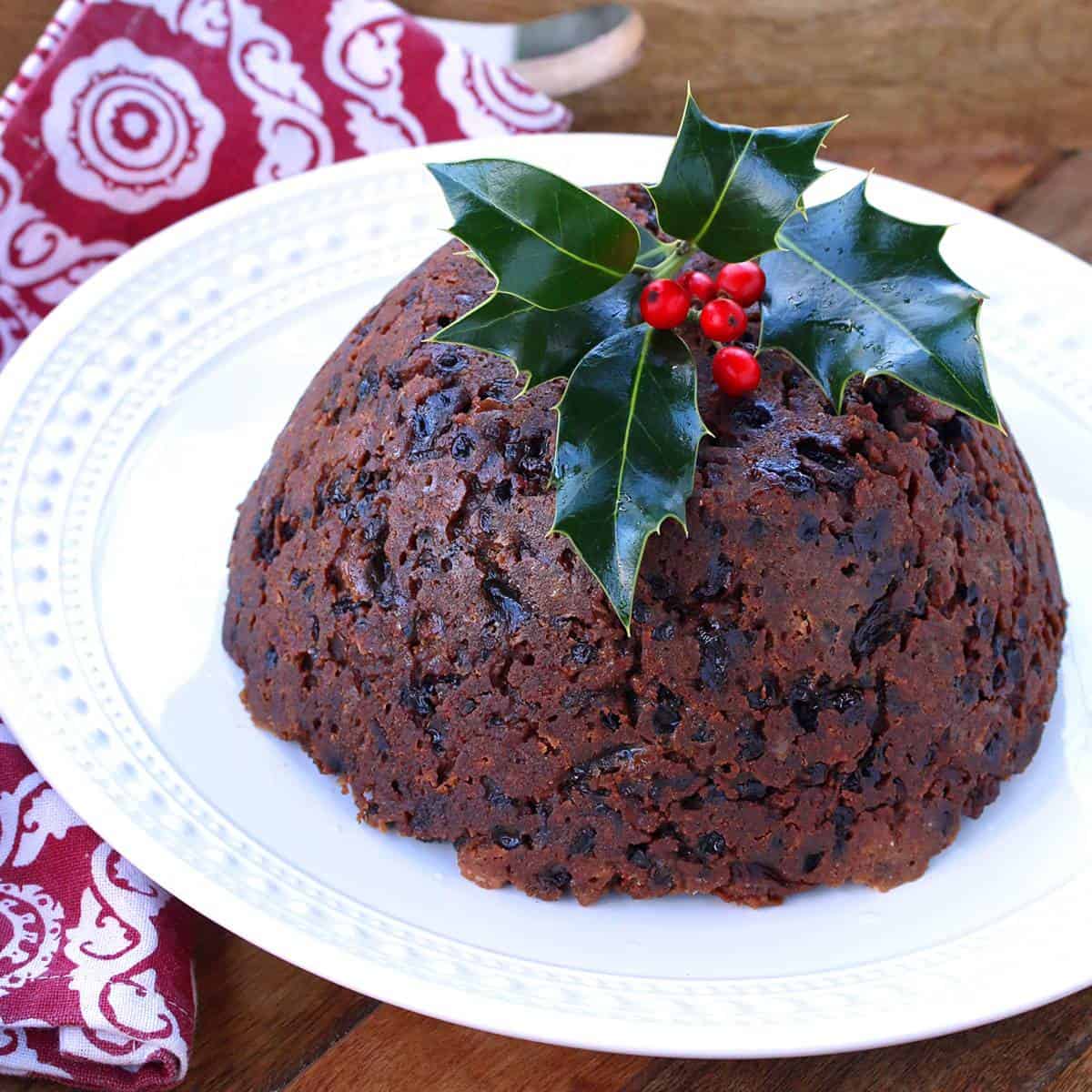
What is Figgy Pudding?
If you’re familiar with the figgy pudding Christmas carol, We Wish You a Merry Christmas, you may have asked yourself at some point, “what is a figgy pudding anyway?”
All three of these names refer to a traditional English steamed cake-like dessert comprised of breadcrumbs, flour, suet, sugar, eggs, brandy, lemon zest, candied citrus peel, spices, and dried fruits (specifically raisins, currants, and golden raisins). With respect to the different names, the short answer is that figgy pudding can be considered a much earlier precursor of plum pudding and they’ve both come to be referred to as Christmas pudding.
Ingredients (hint: no figs or plums)
Figgy pudding dates back to the 14th century and was a much different dish than what we refer to as figgy pudding today. It was more of a wet, sticky, thick porridge consisting of boiled figs, water, wine, ground almonds, raisins and honey. It later evolved into incorporating ground meat and grains and then later still evolved into a steamed pudding that was made with raisins.
Where does the term “plum” pudding come from? Plums were what the pre-Victorians called raisins, and dried fruits in general, and the name stuck. It wasn’t until 1845 when it first came to be called “Christmas Pudding” in Eliza Acton’s bestselling cookbook, Modern Cookery for Private Families.
And so we have three names that are still used in different regions of the English-speaking world. In the U.S. it is more commonly called Figgy Pudding whereas in the UK and Ireland it is more commonly known as Christmas Pudding (or simply “pud”), or Plum Pudding.
As with many traditional Christmas desserts, plum pudding incorporates symbolism reflective of Christ such as the holly (representing the crown of thorns), and setting the pudding on fire (representing the passion of Christ).
Can I Omit the Alcohol?
The brandy serves as a preservative for prolonging the shelf life of the pudding and also draws out more flavor from the ingredients as the pudding matures. You can omit the brandy if you prefer but the pudding will need to be stored in the fridge (wrapped extremely well to prevent drying out) and consumed within a week.
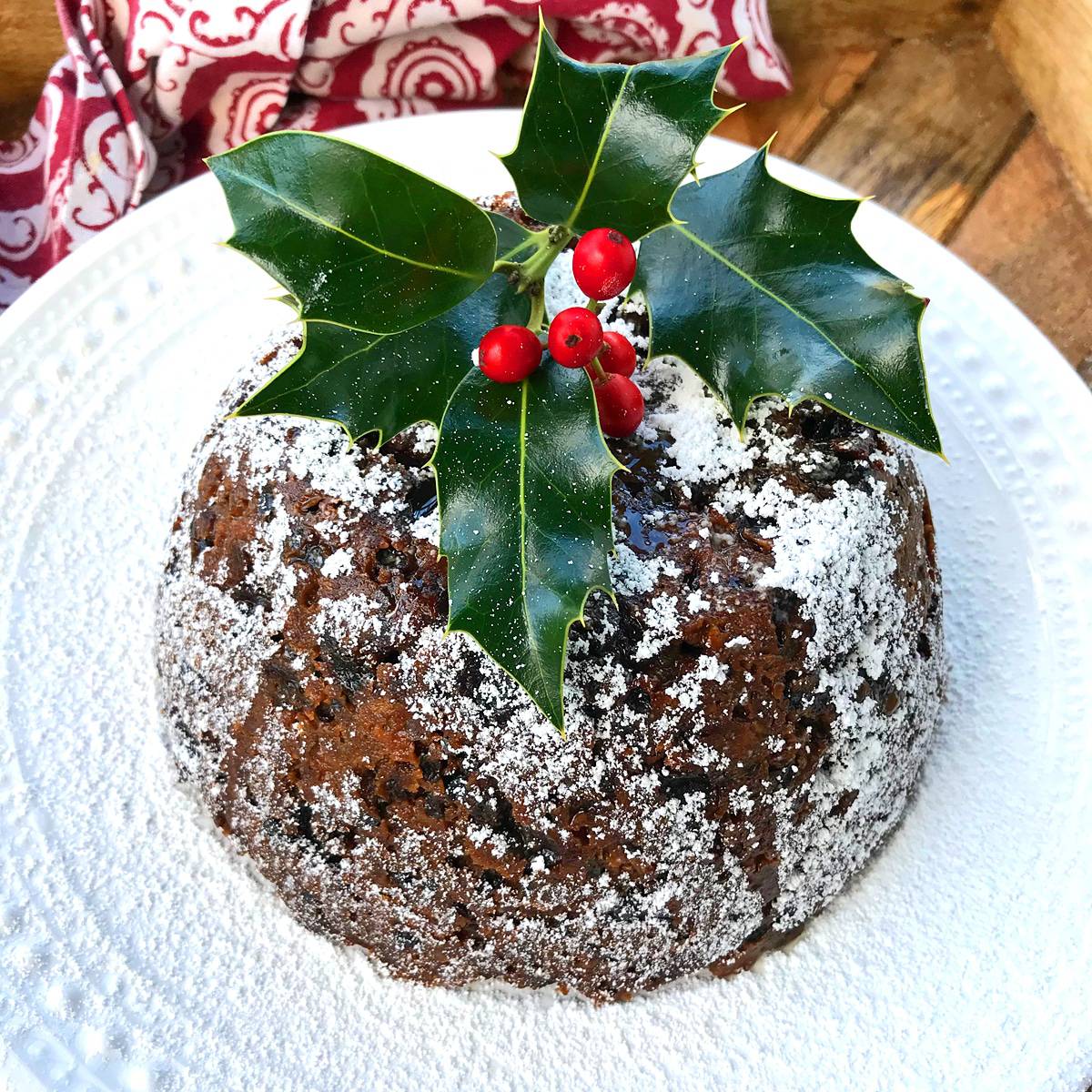
How Long Should You Steam Figgy Pudding?
You’ll see different recipes recommending different times – anything from 3 hours to 8 hours. There’s really no right or wrong to this but if you are using suet, which is traditional and what we recommend for the best texture, you’ll need to steam it for at least 4 hours, preferably longer as it takes suet a long time to break down (longer than butter) and to create the air pockets that gives desserts like this their characteristically soft texture.
The longer you steam the pudding the darker it will become, more closely resembling the pictures of traditional plum pudding you’ve seen. If you want that traditional dark brown color, steam it for closer to 8 hours.
It is very difficult to over-steam a pudding so if you’re uncertain, just keep steaming until your pudding is a rich, dark color.
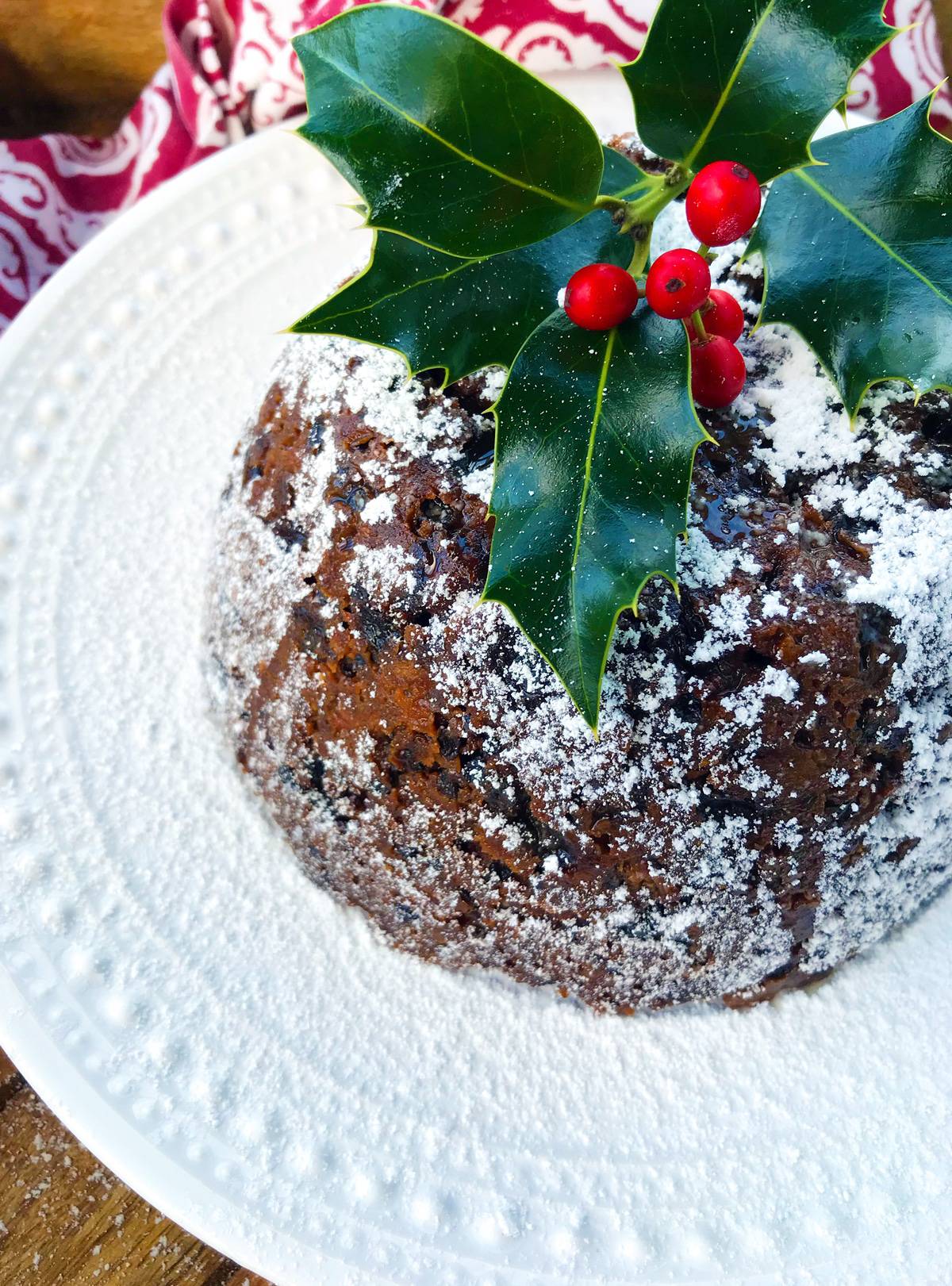
Figgy Pudding Recipe
Let’s get started!
Place the raisins, sultanas, currants, almonds, and candied citrus peel in a bowl. Pour the brandy over and stir to combine the mixture. Cover and let sit overnight to allow the brandy to fully penetrate the fruit.
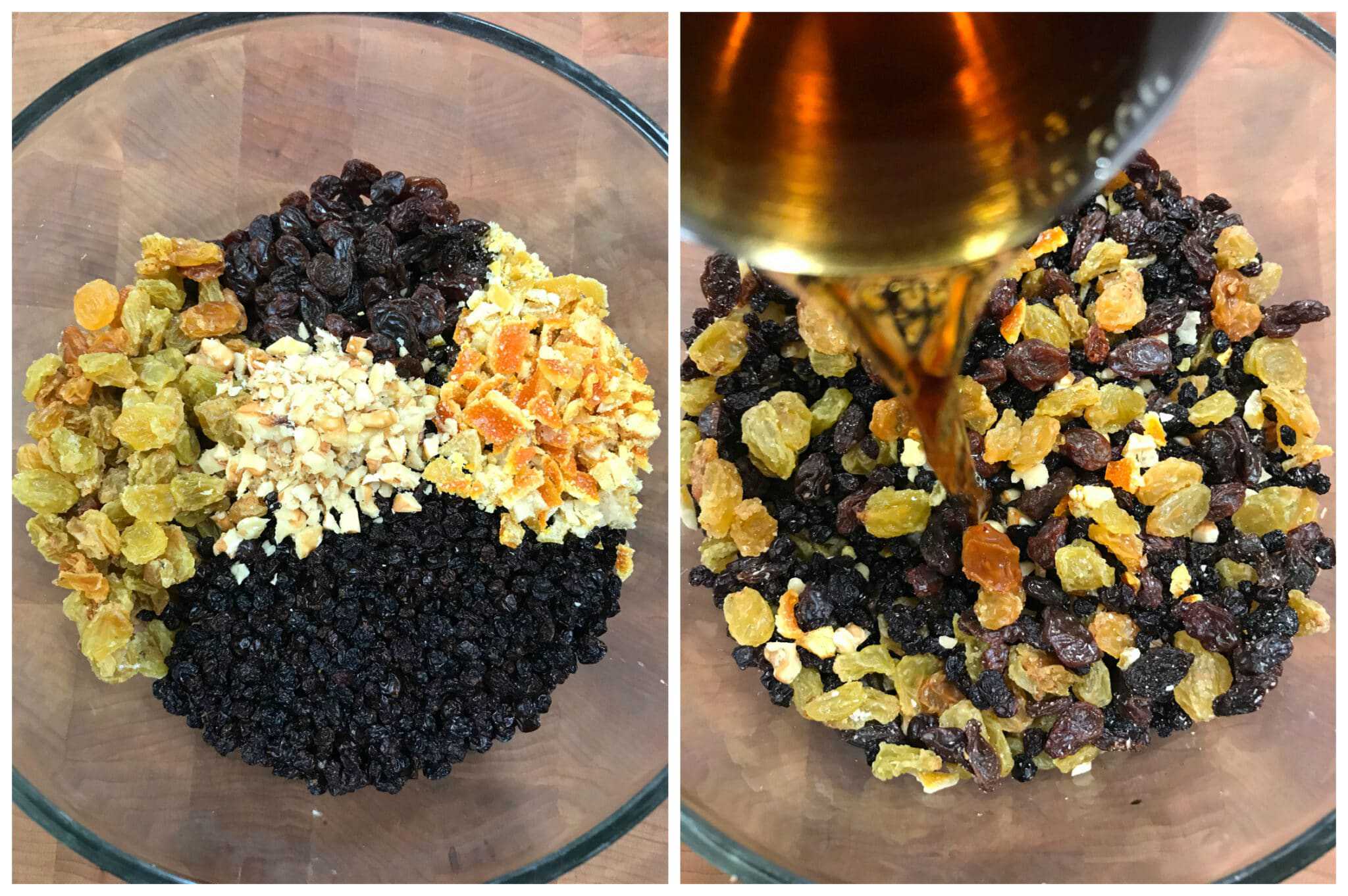
The next day, place the breadcrumbs, flour, brown sugar, baking powder, salt, and spices in a bowl and stir to combine.
In another bowl add the soaked dried fruit mixture, grated apple, suet, lemon and orange zest, black treacle, and egg. Stir to combine.
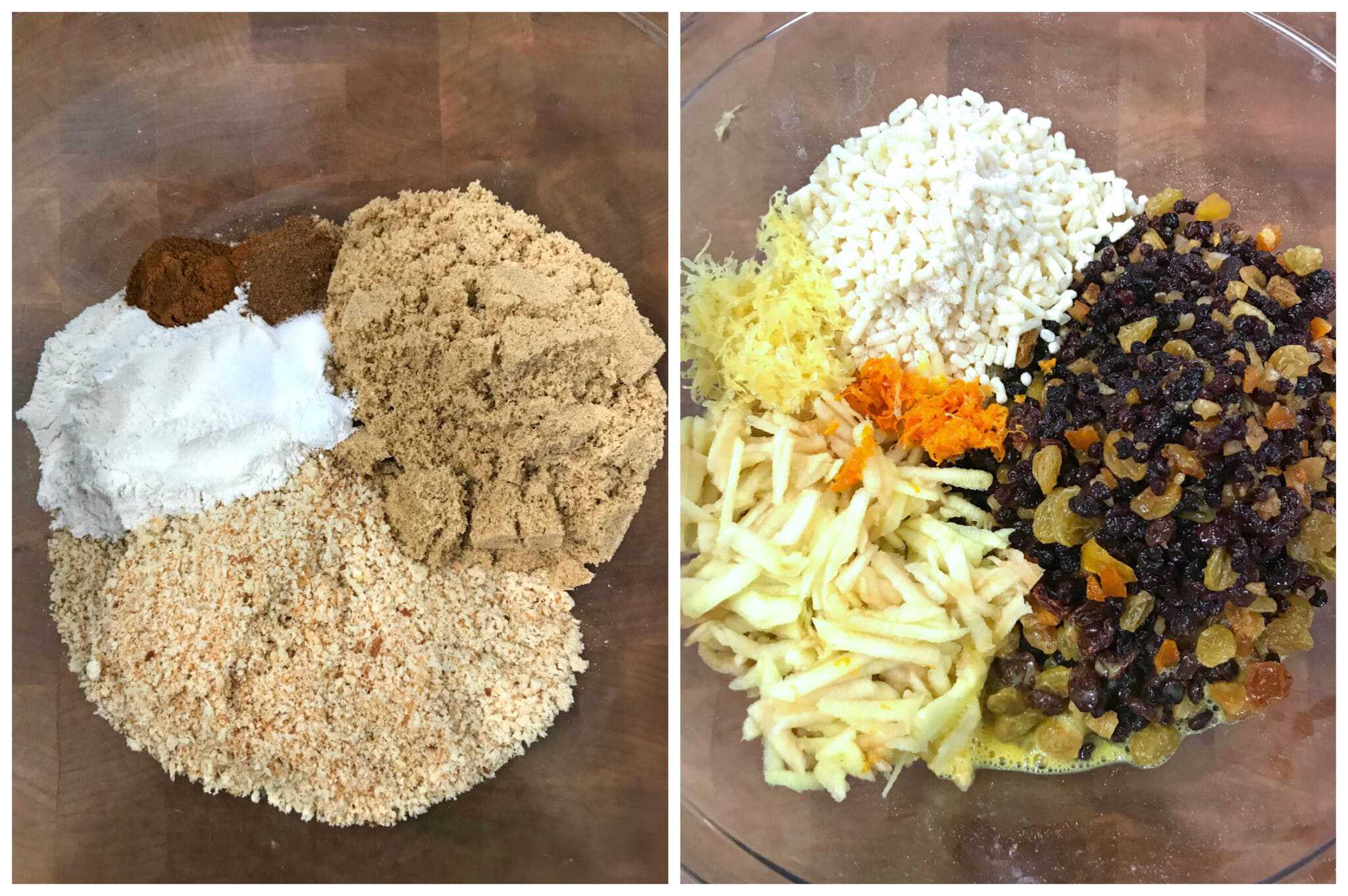
Add the dry mixture to the fruit mixture and stir to thoroughly combine it. It will be thick and sticky.
Generously butter your 2 liter pudding mold and scoop the batter into the mold, pressing down and smoothing the top.
Cut a circle out of parchment paper the same diameter as the top of the pudding mold. Lightly butter the paper and place it, butter side down, on top of the batter. Next tear off two more pieces of parchment paper large enough to cover the to of the pudding mold and partially down the sides of the mold. If your pudding mold is small and the batter comes to the top of it, fold a pleat in the center of the parchment papers to allow room for expansion as the pudding cooks. Trim off excess paper.
Secure the paper by folding down the sides and tying securely with a string (to make it easier you can secure it first with a rubber band while you’re tying it and then remove the rubber band).
Note: If your mold comes with a lid as mine does, I still like to add a layer of parchment paper before securing the lid.
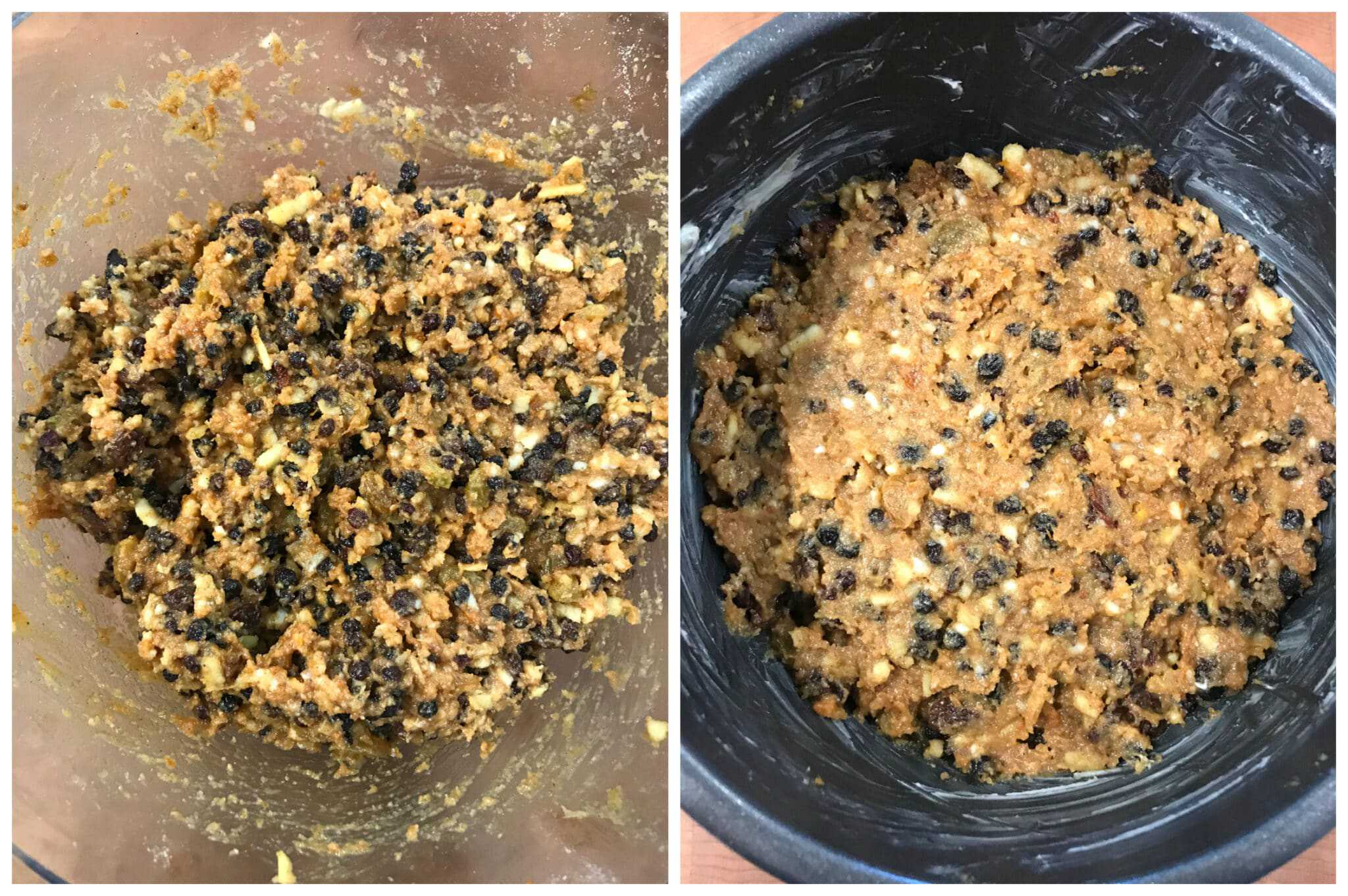
Bring a large pot of water to a very low simmer. Place a folded cloth on the bottom of the pot to prevent the pudding mold from coming in direct contact with the pot in order to prevent scorching.
Lower the pudding mold down into the water on top of the folded cloth. The water level should come up to the halfway point of the pudding mold. Cover the pot with the lid.
Steam the pudding over very low heat for approximately 8 hours. Check periodically to ensure the water level is still at the halfway point and add more water as needed.
The longer the pudding steams the darker in color it will become.
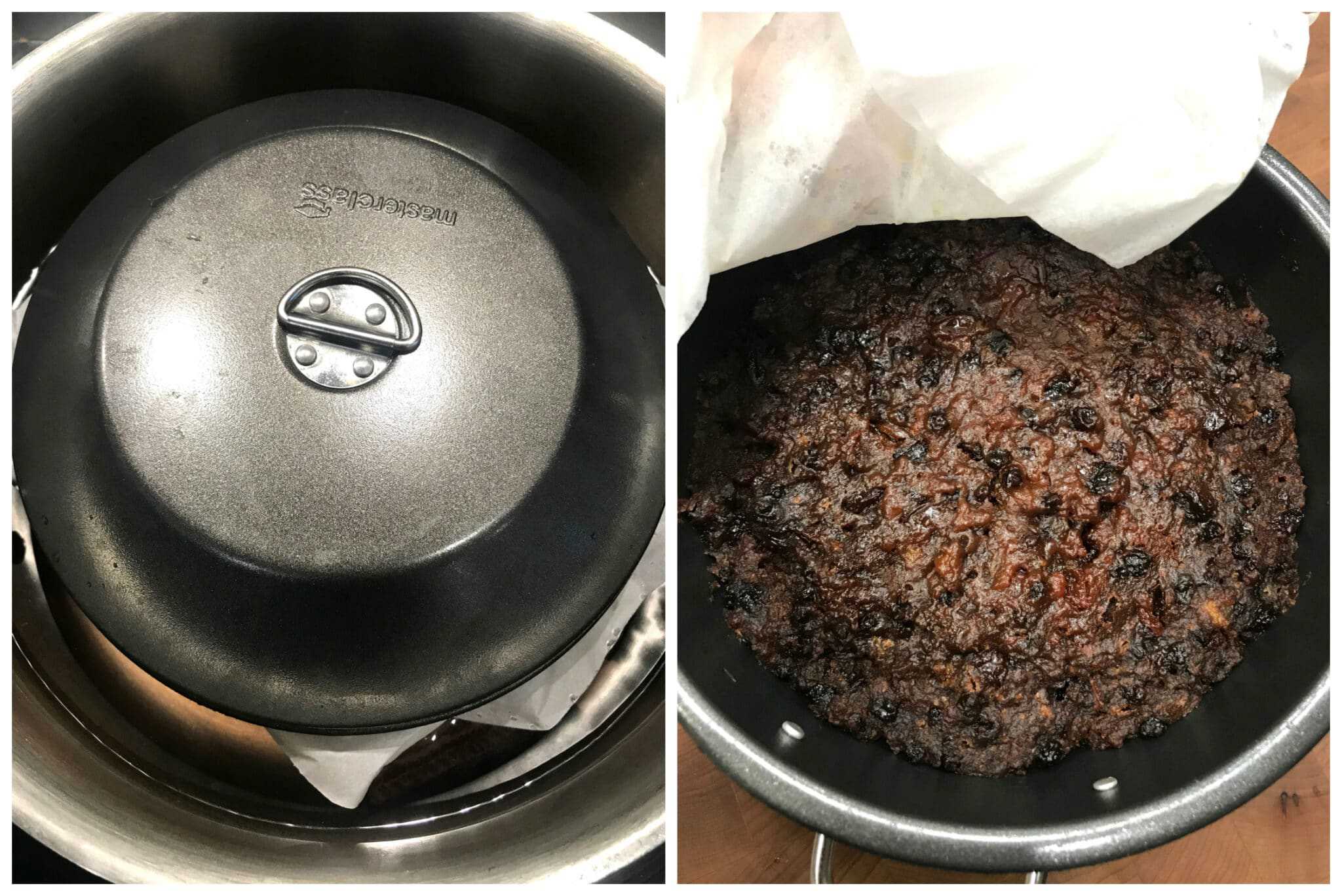
When the pudding is done steaming, carefully lift out the pudding mold and let it sit for 5 minutes. Then invert the pudding on a plate. Let it sit until the pudding slides out onto the plate. Let the pudding cool completely.
To store, if you are freezing it wrap it tightly in at least two layers of plastic wrap, then wrap with foil, and place it in a ziplock freezer bag. remove the parchment paper and wrap the pudding with clean parchment paper followed by aluminum foil. Wrap tightly. Store it in a cool, dark place, preferably a basement. If you don’t have a cool, dark place you can store it in the fridge but first butter the parchment paper before wrapping the pudding to help retain moisture. See storing guidelines section of blog post for more info.
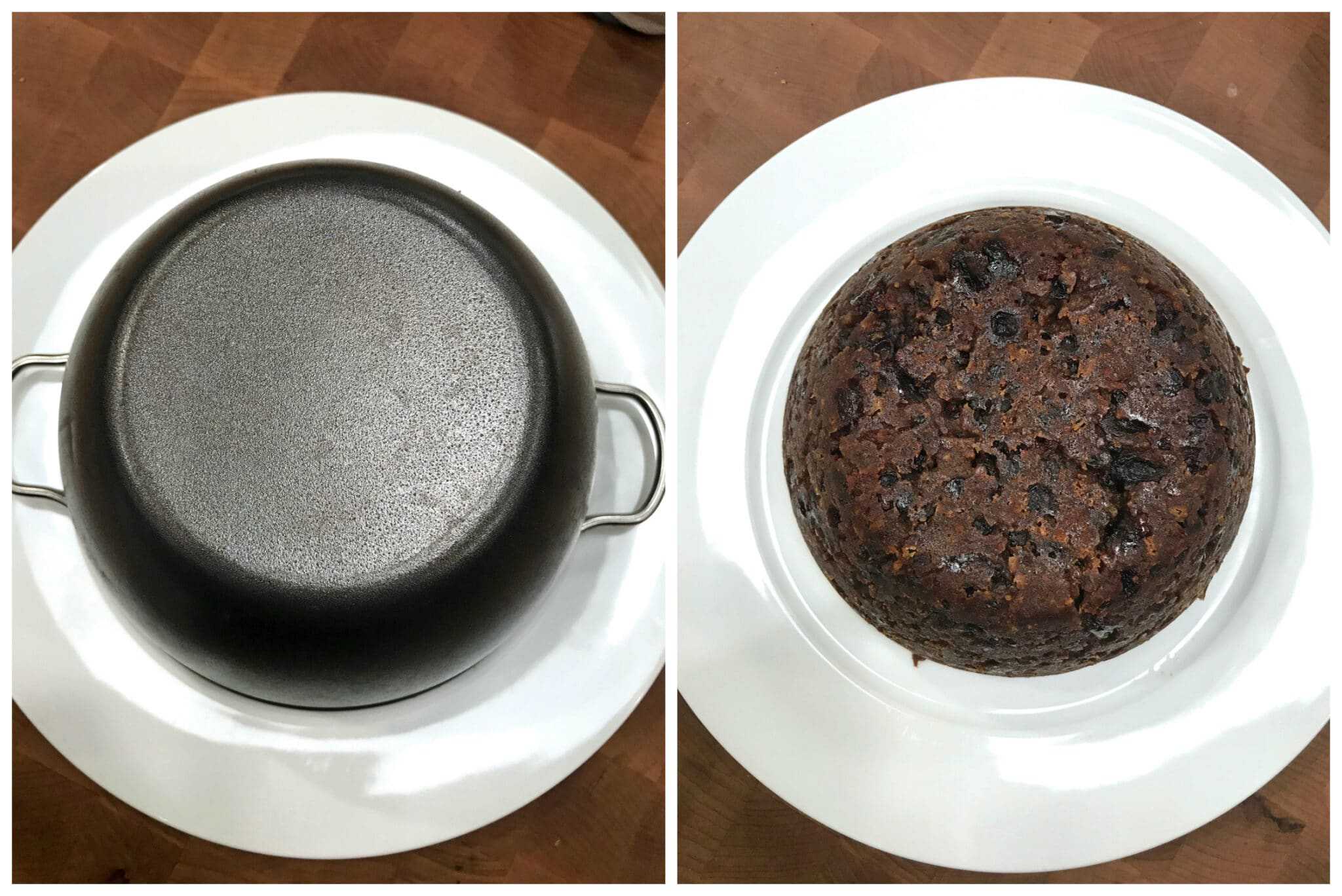
When you’re ready to serve the pudding you will need to reheat it either by re-steaming it for 30-60 minutes or until heated through or you can also microwave it in a microwave safe container to keep the moisture in.
You can light the pudding just before serving (see blog post section on how to light a pudding) and then serve with Hard Sauce, also known as Brandy Butter in the UK. Alternatively you can serve it with a dusting of confectioner’s sugar, some whipped cream, brandy sauce, English custard, ice cream, or lemon sauce.
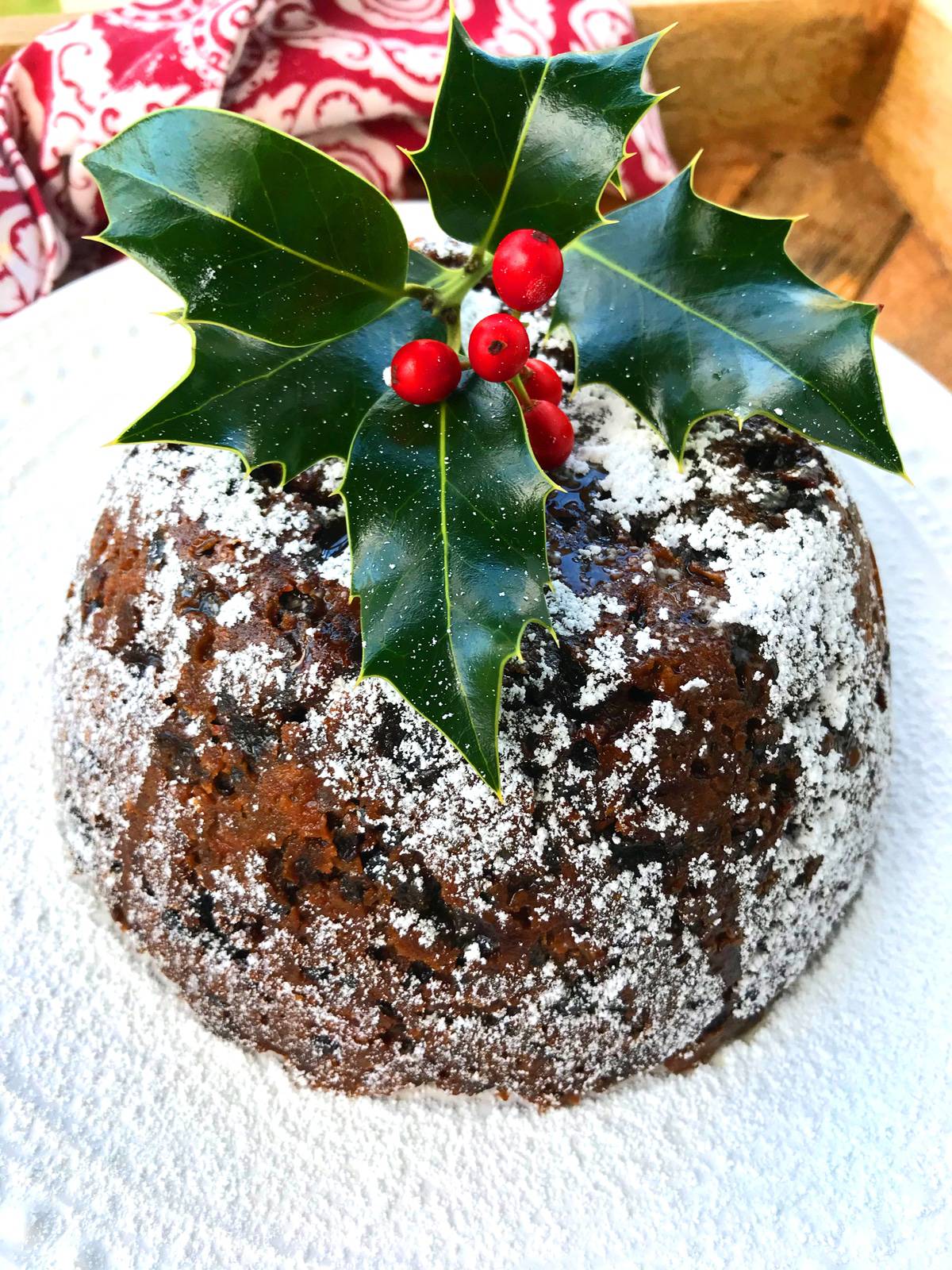
How Far in Advance Should I Make Christmas Pudding?
As with other Christmas goodies that are meant to be made in advance in order to allow their flavors to develop (e.g., Stollen, Lebkuchen, Printen, Springerle, Speculoos, etc), Christmas pudding was traditionally made several weeks before Christmas. The brandy acts as both a preservative and draws out more flavor from the other ingredients. So generally the longer the pudding matures, the more flavorful it will be.
In the UK, Christmas pudding was traditionally prepared on what is known as “Stir-up Sunday” (“stir-up” being a reference from the Book of Common Prayer), the last Sunday before Advent (typically the last Sunday in November, or 5 weeks before Christmas). This was day the pudding ingredients would be assembled and the whole family would be involved “stirring up” the ingredients and then steam the pudding in pudding basins. A popular tradition was to add a silver coin (six pence) to the pudding batter and whoever found the coin in their serving would have good luck. Once cooked and cooled down, the puddings would be carefully wrapped and stored in the basement until ready for serving on Christmas.
How Long Does Figgy Pudding Keep?
Three elements are key to a lengthy storage time: The alcohol and sugar content (preservatives) and proper storage. The pudding needs to be wrapped very tightly and stored in a cool place that is fairly dry but with enough humidity to keep the pudding from drying out. The ideal, and traditional, storage space is a basement or cellar. As long as it is cool but not freezing, a balcony or sheltered area outside out of sunlight will work too. If you do not have a cool, dark environment in your home you can keep it in the fridge but make sure it is tightly wrapped in two layers of plastic wrap and some aluminum foil to prevent it from drying out.
Properly stored, plum pudding will keep for several weeks. (Traditionally it would even be stored for several months, even as long as a year or more, though that makes me a bit nervous.) You can also freeze the pudding for up to a year. Make sure it is well wrapped in two layers of plastic wrap, then aluminum foil, then place it in a freezer bag or airtight container.
How to Reheat and Serve Figgy Pudding
After your pudding is done maturing and you’re ready to serve it, unwrap it, place it back in the pudding mold, cover and re-steam it for 30-60 minutes or until heated through. Alternatively you can cover and microwave the pudding.
The traditional way to serve the pudding is to pour some more brandy over it and set it on fire, letting the fire burn down and then serve it with Hard Sauce, also known as Brandy Butter in the UK. Though hard sauce is traditional you can also serve it with a dusting of confectioner’s sugar, some whipped cream, brandy sauce, English custard, ice cream, or lemon sauce.
How to Light a Christmas Pudding
To set your Christmas pudding on fire pour some brandy, 3-4 tablespoons, into a soup ladle. Hold the ladle over a flame, tipping it slightly to allow the brandy to catch the flame. Once the brandy is on fire, slowly pour the flaming ladle over the top of the pudding; the fire will transfer to the pudding. Wait for the fire to naturally extinguish and then serve the pudding.
Traditionally the pudding is brought to the table, the lights are turned off, and the pudding is set aflame for everyone to see. It’s a guaranteed crowd-pleaser that will elicit “oohs” and “ahhs”!

For more traditional British favorites, be sure to try my:
- Mincemeat
- Mince Pies
- Eccles Cakes
- Sticky Toffee Pudding
- Chelsea Buns
- Hot Cross Buns
- Lardy Cake
- Spotted Dick
- Treacle Tart
- Parkin
Save This Recipe
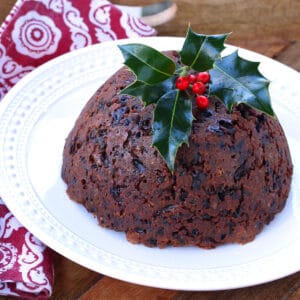
Traditional Figgy Pudding (Christmas Pudding)
Equipment
Ingredients
- 1 cup dried currants (also known as zante raisins)
- 3/4 cup raisins
- 3/4 cup golden raisins/sultanas
- 2 tablespoons finely chopped candied orange peel (click link for recipe, STRONGLY recommend homemade, it makes ALL the difference!)
- 2 tablespoons finely chopped candied lemon peel (click link for recipe, STRONGLY recommend homemade, it makes ALL the difference!)
- 2 tablespoons finely chopped walnuts or almonds , optional
- 1/2 cup brandy (see blog post section about omitting the alcohol)
- 2 cups fresh white breadcrumbs (toast the bread and then pulse in a food processor until you have crumbs)
- 1/2 cup all-purpose flour
- 1/2 teaspoon baking powder
- 1/2 teaspoon salt
- 1 teaspoon mixed spice
- or homemade mixed spice (click link to make your own – I highly recommend it)
- 1 teaspoon ground cinnamon
- 4 ounces shredded beef suet
- 1 cup packed dark brown sugar
- 2 large eggs , lightly beaten
- one small apple , peeled, cored, and grated
- 1 tablespoon black treacle or molasses
- zest of one lemon
- zest of one small orange
- homemade Hard Sauce , for serving (click link for recipe)
Instructions
- Place the raisins, sultanas, currants, almonds, and candied citrus peel in a bowl. Pour the brandy over and stir to combine the mixture. Cover and let sit overnight to allow the brandy to fully penetrate the fruit.
- The next day, place the breadcrumbs, flour, baking powder, brown sugar, and spices in a bowl and stir to combine.In another bowl add the soaked dried fruit mixture, grated apple, black treacle, suet, lemon and orange zest, and egg. Stir to combine.Add the dry mixture to the fruit mixture and stir to thoroughly combine it. It will be thick and sticky.Generously butter your 2 liter/3.5 pint pudding mold and scoop the batter into the mold, pressing down and smoothing the top.
- Cut a circle out of parchment paper the same diameter as the top of the pudding mold. Lightly butter the paper and place it, butter side down, on top of the batter. Next tear off two more pieces of parchment paper large enough to cover the to of the pudding mold and partially down the sides of the mold. If your pudding mold is small and the batter comes to the top of it, fold a pleat in the center of the parchment papers to allow room for expansion as the pudding cooks. Trim off excess paper.Secure the paper by folding down the sides and tying securely with a string (to make it easier you can secure it first with a rubber band while you're tying it and then remove the rubber band).Note: If your mold comes with a lid as mine does, I still like to adda layer of parchment paper before securing the lid.Bring a large pot of water to a very low simmer. Place a folded cloth or trivet on the bottom of the pot to prevent the pudding mold from coming in direct contact with the pot in order to prevent scorching.Lower the pudding mold down into the water on top of the folded cloth. The water level should come up to the halfway point of the pudding mold. Cover the pot with the lid.Steam the pudding over very low heat for approximately 8 hours. The water should not be boiling, it should be steaming. Check periodically to ensure the water level is still at the halfway point and add more water as needed.The longer the pudding steams the darker in color it will become.
- When the pudding is done steaming, carefully lift out the pudding mold and let it sit for 5 minutes. Then invert the pudding on a plate. Let it sit until the pudding slides out onto the plate. Let the pudding cool completely.To store, remove the parchment paper and wrap the pudding with clean parchment paper followed by aluminum foil. Wrap tightly. Store it in a cool, dark place, preferably a basement. If you do not have a cool, dark environment in your home you can keep it in the fridge but make sure it is tightly wrapped in two layers of plastic wrap and some aluminum foil to prevent it from drying out. Follow these same guidelines along with placing the pudding in a ziplock freezer bag to freeze the pudding. When you're ready to serve the pudding you will need to reheat it either by re-steaming it for 30-60 minutes or until heated through or you can also microwave it in a microwave safe container to keep the moisture in.You can light the pudding on fire just before serving (see blog post section on how to light a pudding) and then serve with Hard Sauce (i.e., brandy butter) or powdered sugar, whipped cream, English Custard, ice cream, or lemon sauce.
Nutrition
Originally published on The Daring Gourmet December 15, 2020



















Great recipe, I made mine into 6 individual puddings steamed for 5 hours, they are lovely and dark and smell amazing
Fantastic, Lindsey, thank you so much!
hello
was just wondering..
so the recipes for he candied orange peel and lemon peel are he same to make
Hi Cheryl, yes that’s correct, it’s the same exact method.
May I ask could you suggest a alternative for nutmeg as I have a severe nut allergy which includes coconut and Nutmeg.
Thank you
Hi Sam, mace is the substitute I would suggest but it’s the outer part of the nutmeg and you may be allergic to that as well. I recommend simply omitting it – this pudding will still taste fabulous without it.
Thank you for a wonderful recipe and greetings from Sweden. Plum pudding is not part of our traditional Christmas food. My grand parents always served it but I do not know from where they first got it.
I have tried and compared several old and new recipes and found this the best! Tried once with dried breadcrumbs from the shop. It did not work at all. Made it to some sort of bread like pudding and I had to through it away.
This year I made the pudding for 8 but all figures in the recipe do not follow. So I had to count and check that I got it all right. Would be helpful if you could check that. I also had to figure out the volume of the pudding to prepare the pots.
And again – a great pudding!
Hi Carl, I’m glad you enjoyed it, thank you! I’m not sure I understand what you mean by “all figures in the recipe do not follow.” Can you please clarify?
Does it taste like fruitcake?
Hi Louise, in the sense that it’s made with dried fruits, yes. But if it means anything, I HATE store-bought fruit cakes and most homemade fruit cakes. And one of the primary reasons for that is because they use store-bought candied fruit which in my opinion is one of the nastiest things ever created. This figgy pudding tastes NOTHING like the standard fruit cakes I do my very best to avoid. On the contrary, it’s thoroughly delicious.
Oh my heavens!
That was the best pudding I’ve ever had.
Beats my mum’s pudding, hands down.
This is going into the recipe bank for next year.
Thanks so much for the amazing recipe!
Thank you so much, Ness, I’m thrilled that you enjoyed it! :)
Made it for the first time this Christmas. Do I have to steam it for 8 hours? Seemed a little dry. Otherwise FANTASTIC!
Thank you, Lee, I’m happy you enjoyed it! If you’re using suet then yes, 8 hours (but it’s critical that it’s steamed over LOW heat otherwise yes, it will over-steam and will be dray). If you’re substituting butter for the suet then you’ll steam it less.
Success! I found a small pudding mold at a local thrift store and was eager to try it out! This recipe is great–everything worked successfully. Because my mold seems small and has a central column, I measured the amount, which topped at 1 liter. Without measurements, I decided to halve this recipe because everything is divisible. When I put it into the mold, I learned that I could have probably made the whole thing since once I pushed it down, it only came about half way up.
I steamed for 6 hours and stored it. I made a small batch of hard sauce and served it today on Christmas. It was beautiful and delicious! Definitely a keeper. At half size, it was perfect for 4 people.
Thank you for this great recipe.
Thank you, Donna, I’m so happy you enjoyed it!
So I completely failed at Christmas Pudding one year and I believe I now know why. I had read the tradition was to make it 5 weeks in advance which I did – not steaming it at all until it was time to cook it. Meaning it sat in its raw state for a long long time. Am I right in thinking the however long it is to be stored it needs to be steamed first? And then after the interval re-steamed to heat it up?
Hi Robb, yes that’s correct – steam it first and then store it and the steam again to reheat. Traditionally it was common to “feed” the pudding every now and then by pouring additional alcohol over it and letting it absorb in. I’m not a fan of the potent flavor resulting from that tradition, but it sure made it conducive to setting the pudding on fire at the table!
This is an amazing 600 year old recipe. I realize some ingredients may have changed over time.
I specifically used this recipe as it is the closest I could find from the days that I was in cheffing school.
Thank you for taking the time in publishing this. Definitely steamed it for 6 hours in 6″ X 3.5″ X 2″ mini foil loaf pans (Bought them from Amazon). Covered them in foil tops and low boil. – steamed.
he pan moulds allow me to make slices, heat them up, pour on Brandy at the table and flambe.
As a note, the ingredient combination was a bit dry. I compensated a little milk to make the consistancy more like a drier muffin batter.
Thanks so much for the feedback, Sid, I’m happy you enjoyed the pudding!
My family tradition method did this with a flat sided, lidded small cauldron in a pot belly larger cauldron filled with water over a the fireplace. As my fireplace doesn’t have a cauldron arm and my aunt won’t surrender the pots, I’m looking for a new technique. Can this be done in an mold in a Dutch oven? Or can I use a sous vide technique around my mold? How low is considered low for the temperature?
Hi Christoph, what a fabulously atmospheric tradition! You can use any deep pot. It just needs to be deep enough to allow you to place the lid on the pot to prevent all of the steam from escaping. Very low heat refers to a very low bubbling simmer, enough to generate steam.
What type of cake plate is safe to use for a flaming pudding? The ones I have seen on TV USE stainless steel, but will glass work?
I am making this right now and I have some questions…..the recipe calls for fresh white bread crumbs…but it looks like dried ones in the picture…which do I use? Also, I measured out 150 grams of currants, and it was way over a cup….which do I use?
Hi David, they are fresh breadcrumbs. To make your own breadcrumbs toast the bread (or lay out the slices in the oven) and then pulse them in a food processor until you get crumbs. For the currants, it won’t hurt a bit if you use more than a cup but you can pour some of then back if you want to stick to a cup.
Do you cover the pot while steaming? I have mine on the stove right now and everyone is very excited to find out what this “Figgy Pudding” is lol
Wonderful, Mary, I hope everyone enjoy it! Yes, cover the pot. It keeps the water from evaporating too quickly and prevents your kitchen from becoming a sauna! :)
I couldn’t use alcohol because we have recovering alcoholics in the family. I used tart cherry juice, which is a concentrate. I diluted it. We’ll see how it works. I’m wondering about not using suet. We also have heart disease in the family.
Thank you for this thorough recipe/history lesson!! I can’t wait to try it! We tried a recipe last year and it was so god awfully potent in the alchohol flavor…is there no need then to “feed” the pudding as it matures?? Maybe that’s where it all went wrong..
Hi Jacquelyn, I personally don’t like mine thoroughly drenched in alcohol either. So no, you don’t have to keep feeding it. The primary reason for doing that is as a preservative. Traditionally people would keep these puddings for many months, even a year or more! Unless that is your intention, you can hold off on the additional booze :)